
How to Organize a River Cleanup
How to Clean Up a River: Our Start-to-Finish Guide to Clearing Trash From Your Local Waterway
Individual people are responsible for creating the trash that clogs our waterways, and it’s often up to individual people to clean that trash up. Hosting a river cleanup is a great way to impact the environment and community directly. Picking up trash and other materials from local waterways protects clean drinking water, conserves natural habitats and encourages biodiversity. Plus, you may find a new community with like-minded people. In this comprehensive guide, you’ll get expert advice from seasoned organizations on hosting the most effective cleanup possible.
1. Choose a Time and Location
The first step in planning to clean up a waterway is choosing a location. While this may seem straightforward, there’s a lot to consider to find the perfect spot and ensure it’s accessible to your volunteers.
5 Surefire Signs of a Great Cleanup Spot
- A sizable amount of trash within reach of volunteers.
- Walking distance to parking and the cleanup meeting spot.
- Low, non-poisonous vegetation that won’t conceal trash.
- Multiple access points so all volunteers can participate.
- Away from deep water or dangerous rapids.
If your river cleaning location doesn’t have nearby parking, ask a local business or place of worship if volunteers can use their lots during the cleanup. Tell volunteers to meet at the parking area to carpool to the cleanup site.
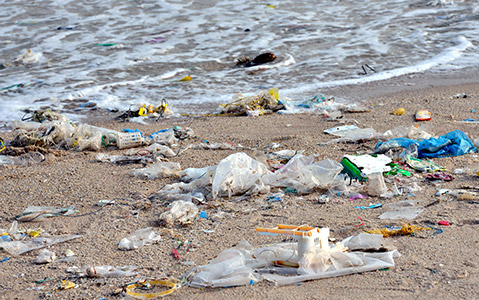
How to Choose a River Cleanup Location
Know the state of your stream:
- How much trash is there? Scout a few streams before deciding on a location to ensure you have trash for your volunteers to pick up.
- Contact a local watershed association, stream watch group or other local environmental group. They can tell you where to find streams in need of a cleanup.
Know the accessibility:
- How deep is the stream?
- How thick is the vegetation along the banks?
- How many access points are there?
- How far away will volunteers be from the trash collection area? Consider that volunteers will have to carry bags of trash back to this point, and waterlogged trash can be heavy.
Pick the best season:
- Late spring is a good choice; as water levels begin to drop, trash is often left above the water line.
- Fall and early winter, which typically have good weather and low water levels, can also work.
- Summer is usually not the best choice, as it’s hot, humid and buggy. Trash is hidden by overgrowth and poison ivy can be a concern.
- Consider participating in International Coastal Cleanup Day, which takes place each year on the third Saturday in September, and join thousands in the effort to clean up waterways nationwide.
2. Get Permission for Waterway Cleanups
It’s important that you have any necessary permission in writing before cleanup day or you could find your project stalled before it even starts. It may be easiest to plan to pick up trash from public property, like a park, since you don’t need as many permits or permissions. However, working with the city or landowners may have more impact if those areas are particularly dirty. To do this, you’ll need permission to clean up there.
Who to Ask for Permits and Permission
Cleaning Up a River by Boat:
Chances are you’ll need permission from a local sheriff’s department, which operates at the county level in most states. Water cleanup allowance could also come from the local city or township, or even a state natural resource department or federal agency. You may need to ask around to figure out the correct governing body to ask, but they will likely grant permission with little to no concern.
Cleaning Up a River on Land:
It can be tricky to figure out the owners of private land, find them and ask for permission. It's even more difficult to gain permission to work with multiple private landowners across property lines.
If a large company holds the land, it can be difficult to gain access due to liability issues. Government-owned properties tend to be easier, but figuring out the property owner can take some work. Use the county plat map and/or records of deeds to find the owners of properties you wish to clean up. For government property, reach out to your city or township’s permitting department. Ensure all your volunteers know of any areas that are off-limits due to declined permission.
It’s important to communicate your plans for your cleanup and get the property owner’s permission in writing. Even if your cleanup is taking place entirely on public property, it’s a good idea to ask the city for a letter of support. While it's not always needed, an official letter from the city can help back you up in case anyone questions your cleanup.
3. Recruit Volunteers
Your river cleanup won’t get far without a group of dedicated volunteers to lend a hand. While there may be many people in your community happy to contribute to a local river cleanup, like those interested in local conservation, the trick is figuring out how to get the word out to those people. Collaborating with local community organizations is a great way to increase your visibility.
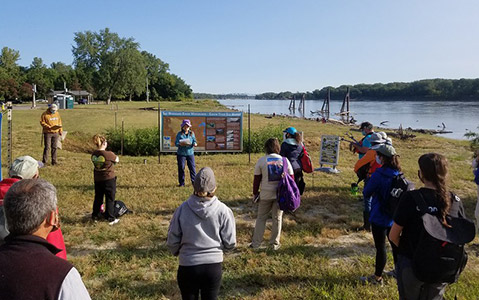
How to Spread the Word About Your Waterway Cleanup
Inform:
- Local community groups, such as scout troops, neighborhood associations or youth groups.
- Local sustainability and environmental groups.
Ask:
- Outdoor sports clubs or outfitters to distribute flyers about the cleanup.
- Local media. Getting an event announcement on a news station, city newsletter or local paper can expose and garner local interest.
- Area VIPs, like city council members and local business leaders, to participate in the cleanup and encourage others to do the same.
Create:
- Listings for your cleanup on volunteer meet-up sites, like Idealist, Create the Good and Just Serve.
- A Facebook event for your cleanup to share with friends, family and local organizations.
- Meta ads for your cleanup targeted to your area and people interested in environmental causes.
Once you’ve spread the word about your event, make sure you have enough information about cleaning up the river to share. Many volunteers are eager to ask questions and help support your cleanup efforts. Some may be willing to take on extra responsibilities, so be ready for some questions.
“Get organized, published and ready to answer questions from prospective volunteers EARLY! One to two months of outreach time is crucial for building support. Last-minute events are incredibly difficult to fill.”
Adam Flett | Friends of the Mississippi River
4. Make Your Site Accessible
Once you’ve found the right avenues to get the word out to volunteers, it’s important to make sure the community cleanup project you’ve planned will be appealing — and accessible — to as many community members as possible. Choosing the right location is especially important, but so is the length of the cleanup and the supplies you offer.
“Two hours is typically a good length for a cleanup — most volunteers will tire around this point. If you’re working with kids, on hot days, etc., you might want to cut it to 90 minutes.”
Alec Norman | Cumberland River Compact
How to Make Cleaning Up Easy for Volunteers
Use the following methods to make your cleanup appealing to potential volunteers:
- Choose a weekend for your cleanup, so that many people will be off work.
- Keep your cleanup length to about two hours, which is manageable for most people.
- Offer to provide supplies for those who can’t bring their own.
- Provide water (preferably in reusable bottles) and snacks for volunteers.
- Provide buckets or other containers for sharp items so volunteers aren’t at risk of cuts.
- Make the cleanup open to children, so interested parents can easily participate.
- Finalize the details and be ready to answer questions before seeking out volunteers.
- Make different people responsible for certain aspects of the cleanup.
5. Gather Tools and Supplies
Eager volunteers are the most important element of a successful waterway cleanup, but they’re not the only piece of the puzzle. You’ll need to make sure those volunteers are armed with the right quantities of the right materials to get the job done efficiently and, most importantly, safely.
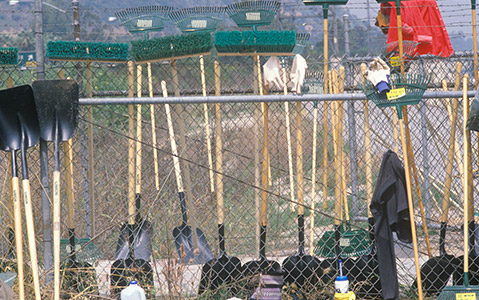
“My advice is to reach out to organizations that can provide supplies and haul away all the debris on the day of the cleanup. Otherwise, things can become cumbersome.”
Joseph Reynolds | Bayshore Regional Watershed Council
Need a dumpster to haul away the mess?
What Tools Do You Need to Clean Up a River?
Flett suggests the following materials to make your river cleanup easier:
Tools | Supplies |
|---|---|
High-quality trash bags | Bug spray |
Trash pickers | Water and snacks |
Gloves | First aid kit |
- Stock at least two to three trash bags per volunteer.
- Instead of work gloves, stock medical gloves, planning to have about 20 more pairs on hand than volunteers in case of tears. They are cheaper and usually sturdy enough for trash.
- Ask local grocery stores and other retailers for donations of trash bags, gloves, trash pickers and first aid kits.
- Keep in mind that long grill tongs can be used instead of trash pickers if needed.
- Ask local grocery stores or other food vendors to donate water and snacks for the cleanup.
- Contact local businesses, places of worship and community groups to ask for financial donations to cover costs for anything you aren’t able to get via in-kind donations.
- Register with National River Cleanup. This program provides trash bags to cleanups of all sizes for free.
Once any donations have come in, you can ask volunteers for help acquiring any supplies that are still needed. However, you should make it clear that no one is obligated to provide supplies and no one will be turned away for being unable to contribute.
6. Clean Up the River
Now that you’ve found a cleanup location, gotten the right permissions to clean up the river and found volunteers and supplies, it’s time to get to work. Use the river cleaning method below to ensure a successful community cleanup.
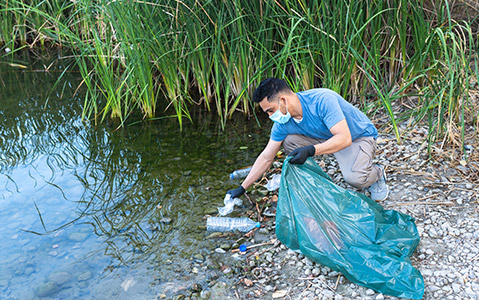
How to Organize a River Cleanup
Start the day by setting your sign-in lists out so you know how many people attend the event. This is great for tracking how many supplies you may need for future cleanups. It also makes it easy to contact these people for help at other events.
Once your volunteers have arrived, delegate tasks to specific people or groups and make sure you have enough supplies. Then, send people off to clean.
“It's helpful to have different people with autonomy over different aspects of the event. For example, for our cleanups, we ask one person to be the Cleanup Boss, another to be the Publicity Boss, etc. As long as everyone communicates with each other, it takes the pressure off of one individual to cover all the details. Some people prefer ‘Hero’ or ‘Guru’ to ‘Boss’ to discourage people from being bossy!”
Steve Schnarr | Missouri River Relief
7. Sort Materials
Once your river cleanup is complete, you’ll have played a major role in improving your community’s environmental health. But why not go one step further? You can make an even bigger impact by separating the recyclables from the rest of the litter you’ve collected to ensure they don’t end up in a landfill.
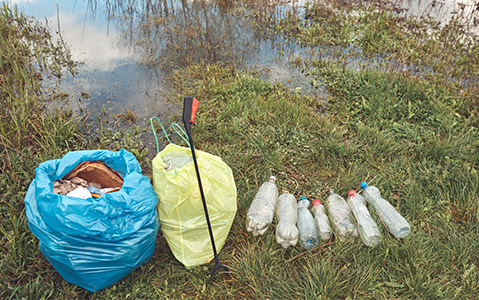
How to Keep Your River Cleanup Litter Organized
Choose to separate recycling as you work if any of the following circumstances apply:
- You don’t have time and/or a suitable location to separate recycling afterward.
- Your area does not have particularly strict recycling guidelines, making a rough sort acceptable.
- Your area’s recycling guidelines are simple enough for volunteers to remember off-hand while they work.
If you choose to separate recyclable materials as you work, it’s best to have two bags. Supply volunteers with one clear bag for recycling and a black bag for trash.
Choose to separate recycling post-cleanup if any of the following circumstances apply:
- Your area has strict recycling guidelines that would make sorting as you work difficult.
- Your area’s recycling guidelines aren’t simple enough for volunteers to remember while they work.
- You want to keep detailed records of the various items you’re recycling.
If you’re recycling after your cleanup, we recommend doing this with a smaller group. Or, find examples of accepted and unaccepted recyclables for your volunteers to look at as they sort.
Overall, it’s best to check what materials your local recycling facility allows. Not all recycling centers accept the same types of materials. For example, many will not take glass. Ask specific questions, like what plastic numbers they take or whether tires are acceptable.
“Tires are one of the most recyclable large objects commonly found in streams, so consider recycling tires through Bridgestone’s Tires4ward program."
Alec Norman | Cumberland River Compact
8. Get Rid of the Litter
The biggest mistake you can make when planning a river cleanup project is forgetting to have a plan in place for getting rid of all the trash you remove from the waterway. This step is particularly important because you don’t want to neutralize all the environmental good you did by failing to ensure that the trash is properly handled.
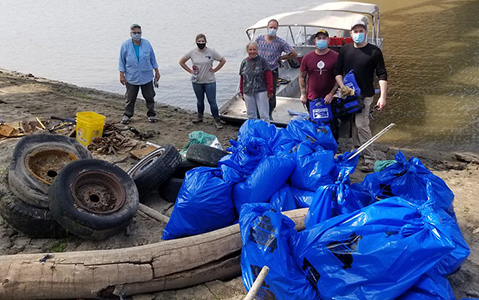
“Organize trash pickup beforehand — some cities may work with you to come collect the trash directly, or you may want to rent a dumpster. Make a note of large, difficult-to-move items (appliances, car parts, etc.) and let local watershed groups know in case they’re able to arrange future removal.”
Alec Norman | Cumberland River Compact
Rent a Dumpster for Efficient Cleanup
Don’t Leave a Mess After Your River Cleanup!
Use the following methods to get rid of trash post-cleanup:
- Contact your city’s department of public works, public services department, department of solid waste or waste collection department to request free trash removal for your cleanup.
- If the city cannot provide trash pickup, contact a roll off dumpster rental company. Inquire about any potential discounts for volunteer events.
- If volunteers find items too large to move, contact a local environmental group that may be able to handle them.
- Make sure volunteers know not to handle hazardous materials such as syringes or other medical waste. Instead, contact the city’s household hazardous waste department to arrange safe disposal.
- Estimate how much trash was collected by multiplying the total number of bags by 15. While it's not an exact science, this will give you a rough idea of how many pounds of trash you collected in your cleanup.
Are You Ready to Clean Up Your Local Waterway?
With these tips, you should be well on your way to planning a river cleanup that will not only leave your community with a healthier waterway but will hopefully inspire continuing cleanup efforts.
If you’re looking for additional resources or more ways to get involved with river protection, please visit the wonderful organizations that helped make this guide possible: